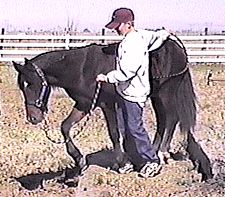Building Yourself a "Horse Course"Part Three: A Footing Mound |
|
We built our mound using the dirt which we dug out to make our pit. The idea here was to create a rectangular mound about 5 feet high by 4 feet wide by 16 feet long. The slopes at each long end were gradual, about a 25% grade. The slopes along both sides are steep, one dropping off naturally and the other having two 12 foot redwood timbers installed to act like steps.  Horses are introduced to the mound "lengthwise", rising and descending along the gentler slopes. The rider soon discovers that balance (staying on a vertical plane) is important if the horse is going to negotiate the mound without feeling the need to "rush". Once lengthwise approaches are working smoothly, it's time to negotiate the steeper sides and the "stairs". Once the horse and rider are accustomed to this obstacle, it can be taken in combination with other obstacles (e.g., the pit).  We have found this obstacle to be as useful in developing rider balance as it is in improving horses' footwork. Note: When working around any obstacles, you need to pay careful attention to your situation, your horse, any distractions and what others nearby are doing (what impact they may have on you and what impact you may have on them). Some horses may react unpredictably and you need to be prepared to guide them through any situation... or get competent assistance if you are not sure how to do so! Continue to Part FourReturn to Part TwoPress "Back" to return to the page that brought you hereGo to Case Study SectionReturn to Training SectionReturn to Wild Horse MentorsReturn to KBR World of Wild Horses and BurrosGo To
|
